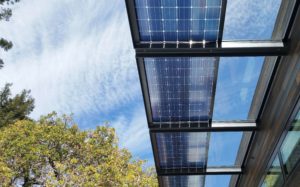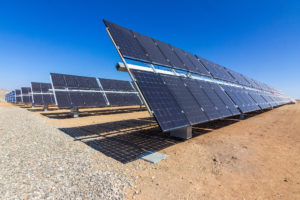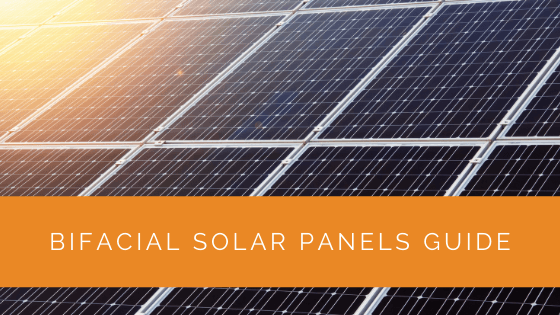Harnessing the power of the sun has long been a cornerstone of our quest for sustainable energy solutions. Amidst the array of solar technologies, bifacial solar panels have emerged as an exciting advancement that promises increased efficiency and versatility. In this guide, we will delve into the fascinating world of bifacial solar panels, shedding light on how they work and the numerous benefits they offer.
Traditional solar panels have paved the way for renewable energy, but they have limitations when it comes to maximizing sunlight absorption. Bifacial solar panels, equipped with solar cells on both sides, are changing the game by capturing light not just from the front but also from the rear, even bouncing off reflective surfaces. Join us as we explore the mechanics, advantages, and installation considerations of bifacial solar panels, empowering you to make informed choices in your journey towards a greener future.
Contents
- 1 Key Takeaways
- 2 How Do Bifacial Solar Panels Work?
- 3 Benefits of Bifacial Solar Panels
- 4 Monocrystalline Vs. Polycrystalline Solar Cells
- 5 Can Bifacial Solar Panels Produce More Energy?
- 6 Installation of Bifacial Solar PV Panels
- 7 How Can You Increase The Output Of A Bifacial Module?
- 8 Case Study: Enhancing Energy Efficiency with Bifacial Solar Panels
- 9 Expert Insights From Our Solar Panel Installers About Bifacial Solar Panels
- 10 Discover the Power of Solar with Solar Panels Network
- 11 Endnotes
Key Takeaways
- Bifacial solar panels have solar cells on both sides, allowing them to absorb light from the front and rear, increasing efficiency.
- Benefits of bifacial panels include enhanced efficiency (10% to 12% more energy than monofacial panels), durability, and the requirement for fewer panels for the same energy production.
- Bifacial panels can produce more energy when placed near reflective surfaces and can be installed horizontally or vertically, offering flexibility in placement and higher efficiency.
How Do Bifacial Solar Panels Work?
In traditional (monofacial) solar panels, light energy that can’t be absorbed is reflected away while the other side of the panel absorbs the light.
On the other hand, bifacial solar panels feature solar cells on both sides of the panel. As a result, the panels can absorb light from both the front and rear.
Regarding its practicality, this implies a bifacial solar panel may absorb light reflected from the ground or another substance.
Benefits of Bifacial Solar Panels
Bifacial solar panels are becoming increasingly popular in the solar industry because of their low cost and higher efficiency. Bifacial panels are increasingly being used in place of monofacial ones by individuals and companies alike. Let’s discuss some of the major benefits of installing solar panels made of bifacial systems.
Enhanced Efficiency
Comparatively, they generate a lot more power than traditional panels.
According to a recent LONGi solar study, bifacial systems generate 10% to 12% more energy than monofacial systems. A tracking device automatically tracking the sun to maximise irradiation during the day can increase this by 27%. Reduced electricity bills are just a bonus!

Strong and Durable
It is common for bifacial panels to be more robust since they are frameless and have tempered glass on both sides.
Tempered glass can tolerate extreme temperatures, UV rays, and powerful winds. For this reason, bifacial solar panels are projected to last longer than other types of panels.
Fewer Panels Are Required
The result of increased efficiency is that fewer panels are needed to produce the same quantity of electricity.
You only need to use ten bifacial panels for the same amount of energy as 12 monofacial panels. They are ideal for homes with limited roof space because of this.
Reduced PID
Because there isn’t any frame around a bifacial solar panel system, the solar cells are less likely to be damaged by potential-induced degradation (PID). Solar panels deteriorate when electrical currents deviate from their intended course.
There is no need for grounding on bifacial panels without metal frames since there are no exterior metal connections.
Looks Good and Works Well in Low Lighting
A wide variety of bifacial modules are available, including entirely frameless ones. Compared to monofacial panels, many people prefer the aesthetics of the full-frame glass design.
Since bifacial solar systems have a larger surface area, they are more effective in dim light. This makes bifacial solar panels less expensive in the long run.
Extended Warranties
Bifacial panels outlast monofacial panels thanks to glass on both sides of the solar cells.
As a result, most bifacial panels have 30 years or more warranties instead of the 20-25 years that traditional solar panels have.
Flexible Installation Options
Space-constrained settings requiring maximal power production capacity may find this a suitable choice.
A higher angle or even vertical mounting is possible to aid in the removal of snow as well as dust and sand.
Monocrystalline Vs. Polycrystalline Solar Cells
Monocrystalline cells are more common in most bifacial solar panels than polycrystalline ones due to their higher efficiency and improved low-light performance.
That said, monocrystalline cells are more costly than their polycrystalline counterparts. Bifacial panels have twice as many cells as monofacial ones, making this an even bigger issue.
Monocrystalline panels are a good choice if you have a small amount of floor space and are prepared to spend more to get more energy yield and the best return on your investment. These solar panel prices may be high, but they are worth it.
Can Bifacial Solar Panels Produce More Energy?
Bifacial solar panels can produce electricity at peak performance near highly reflecting surfaces. Some examples of such reflective surfaces include glass, sand, stone, and snow.
It’s still possible to increase electrical energy output by up to 30% even when the front of the solar cell absorbs most of the reflected light. The quantity of additional power output by bifacial solar cells will be influenced by the environment in which they are installed.

Installation of Bifacial Solar PV Panels
Another feature of bifacial panels that is sometimes ignored is that they may be installed horizontally or vertically. This gives you more alternatives when finding a place to install your panel.
- Horizontally: Rooftops are the most common location for horizontally installed panels. The panel’s bottom captures light in horizontal planes. This is not the most efficient installation method because the underside generates less energy than the top.
- Vertically: When installed vertically, panels are normally set onto movable frames set into the ground. The panel is angled to maximise the amount of sunlight it absorbs. Ground-mounted solar panels are more expensive to install than roof-mounted panels in terms of cost and area.
How Can You Increase The Output Of A Bifacial Module?
Regarding solar radiation, the photovoltaic module’s front receives direct sunlight, while the rear receives reflected sunlight from the ground and other nearby objects. This is also known as the albedo effect.
When you compare monofacial panels to bifacial panels, the latter tend to perform better thanks to their utilisation of back radiation. When surfaces reflect sunlight, bifacial modules can generate significantly more electricity from their rear side, typically up to 35% more.
Four key elements influence the bifacial module efficiency.
Height of the Module from the Ground
These bifacial solar modules should be installed at least 20cm above the surrounding surface for optimal bifacial gain. As a side note, this rule only applies at less than one-metre distances. As you get higher, the bifacial gain decreases significantly.
Tilt Angle of Module
Like regular PV systems, larger tilt angles yield greater bifacial gains. Bifacial technology can benefit solar panels with a 10° inclination.
Distance between the Rows
A wider row spacing allows more light to reflect off the back sheet of the modules and reach the ground.
The Albedo Effect: Game changer
Most solar installers have never heard of this word before. Based on surface reflectivity, a brighter surface has a greater albedo light effect.
The albedo light value needs to be greater to get more power out of a module. For this reason, a white roof or snow-covered ground provides the best bifacial gain.
Improvements are slightly smaller but still significant on a light grey/beige roof. The bifacial gain for asphalt or black coverings is small; however, it should be considered for all flat roofs.
Case Study: Enhancing Energy Efficiency with Bifacial Solar Panels
Background
At Solar Panels Network, we continuously strive to offer the most advanced and efficient solar solutions to our clients. A recent project provided an excellent opportunity to showcase the benefits of bifacial solar panels, highlighting their increased efficiency and versatility in various installation environments.
Project Overview
Our client, a commercial property owner, approached us to reduce their energy costs and environmental footprint. The property featured a mix of rooftop and ground space, making it ideal for bifacial solar panel installation. The client’s primary goals were to maximise energy production and minimise the number of panels required due to limited space.
Implementation
- Bifacial Solar Panels: Chosen for their dual-sided solar cells, capable of capturing light from both the front and rear.
- Aluminium Mounting Frames: Used for their strength and ability to support the panels in varying orientations.
- Reflective Ground Surface: A white reflective surface was prepared beneath the ground-mounted panels to enhance light absorption.
- Monitoring System: An advanced system to track energy production from both sides of the panels.
Results
- Increased Energy Production: The bifacial panels produced approximately 15% more energy compared to traditional monofacial panels, thanks to their dual-sided light absorption.
- Optimised Space Utilisation: Fewer panels were needed to achieve the desired energy output, allowing for efficient use of limited rooftop and ground space.
- Enhanced Durability: The tempered glass design ensured the panels could withstand harsh weather conditions, reducing maintenance costs.
- Positive Client Feedback: The client reported a noticeable reduction in energy bills and expressed satisfaction with the system’s performance and aesthetics.
Summary
This project demonstrated the substantial benefits of bifacial solar panels in a commercial setting. By harnessing light from both sides, these panels offered a higher energy yield and efficient space utilisation, aligning perfectly with the client’s needs. The reflective ground surface further amplified the panels’ effectiveness, showcasing the importance of strategic planning in solar installations. Our team’s expertise ensured a seamless installation process, resulting in significant energy savings and a satisfied client.
Expert Insights From Our Solar Panel Installers About Bifacial Solar Panels
Bifacial solar panels are a game-changer in the solar industry. Their ability to harness sunlight from both sides significantly increases energy yield, making them an excellent choice for both residential and commercial installations.
Chief Solar Technician
The dual-sided design of bifacial panels allows for more flexible installation options, whether on rooftops or ground mounts. This versatility, combined with their enhanced durability, makes them a preferred option for long-term investment in solar energy.
Solar Installation Specialist
One of the standout features of bifacial panels is their performance in low-light conditions. Even on overcast days, these panels can capture diffused sunlight, ensuring a consistent energy output throughout the year.
Renewable Energy Consultant
Discover the Power of Solar with Solar Panels Network
Are you navigating the world of solar installations? Look no further than Solar Panels Network, the UK’s trusted partner in harnessing the sun’s potential. Our dedication goes beyond just installations; we’re on a mission to transform how homeowners and businesses across the UK perceive and utilise energy. By choosing us, you’re reducing your carbon footprint and making a smart financial move that promises savings for years ahead. Contact us today and embark on your solar journey.
Endnotes
Bifacial solar panels are a significant step forward in solar panel technology since they increase efficiency while taking up the same amount of space as single-faced panels.
Commercial and residential applications can benefit from the greater efficiency of bifacial panels. Since fewer panels are required to create the same amount of electricity, they are best suited for installations with a limited area.
Roof space is a limiting factor for more than half of all European commercial and industrial rooftop developments. It is also common for houses to have significant energy consumption demands.
As a result, the more environmentally friendly electricity that can be generated using natural resources, the better. Therefore, using high-power modules such as bifacial makes more sense than ever.
About the Author
Solar Panels Network stands at the forefront of solar energy solutions, driven by a team of seasoned solar engineers and energy consultants. With over decades of experience in delivering high-quality solar installations and maintenance, we are committed to promoting sustainable energy through customer-centric, tailored solutions. Our articles reflect this commitment, crafted collaboratively by experts to provide accurate, up-to-date insights into solar technology, ensuring our readers are well-informed and empowered in their solar energy decisions.

